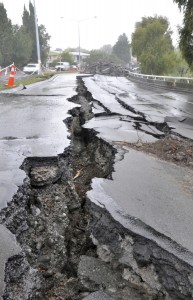Are you prepared for an earthquake?
Earthquakes strike suddenly, violently, and without warning at any time of the day or night. Although there are no guarantees of safety during an earthquake, identifying potential hazards ahead of time and advance planning can save lives and significantly reduce injuries and property damage.
 What to Do Before an Earthquake
What to Do Before an Earthquake
- Be Informed
- Make an Emergency Communication Plan: Identify a contact such as a friend or relative who lives out-of-state for household members to notify them they are safe. It may be easier to make a long-distance phone call than to call across town, so an out-of-town contact may be in a better position to communicate among separated family members. Be sure every member of your family knows the phone number and has a cell phone, or a prepaid phone card to call the emergency contact. If you have a cell phone, program that person(s) as “ICE” (In Case of Emergency) in your phone. If you are in an accident, emergency personnel will often check your ICE listings in order to get a hold of someone you know. Make sure to tell your family and friends that you’ve listed them as emergency contacts.
- Build A Kit:
- Water, one gallon of water per person per day for at least three days, for drinking and sanitation
- Food, at least a three-day supply of non-perishable food
- Battery-powered or hand crank radio and an NOAA Weather Radio with tone alert and extra batteries for both
- Flashlight and extra batteries
- First aid kit
- Whistle to signal for help
- Dust mask to help filter contaminated air and plastic sheeting and duct tape to shelter-in-place
- Moist towelettes, garbage bags, and plastic ties for personal sanitation
- Wrench or pliers to turn off utilities
- Manual can opener for food
- Local maps
- Cell phone with chargers, inverter or solar charger
What to Do During an Earthquake
- Do not run outside. Do not get in a doorway as this does not provide protection from falling or flying objects, and you may not be able to remain standing.
- Drop down onto your hands and knees so the earthquake doesn’t knock you down.
- Cover your head and neck with your arms to protect yourself from falling debris.
- If you are in danger from falling objects, and you can move safely, crawl for additional cover under a sturdy desk or table.
- If there is low furniture or an interior wall or corner nearby, and the path is clear, these may also provide some additional cover.
- Stay away from glass, windows, outside doors and walls, and anything that could fall, such as light fixtures or furniture.
- Hold on to any sturdy covering so you can move with it until the shaking stops. Stay where you are until the shaking stops.
If getting safely to the floor to take cover won’t be possible:
- Identify an inside corner of the room away from windows and objects that could fall on you. The Earthquake Country Alliance advises getting as low as possible to the floor. People who use wheelchairs or other mobility devices should lock their wheels and remain seated until the shaking stops. Protect your head and neck with your arms, a pillow, a book, or whatever is available.
If you are in bed when you feel the shaking:
- If you are in bed: Stay there and Cover your head and neck with a pillow. At night, hazards and debris are difficult to see and avoid; attempts to move in the dark result in more injuries than remaining in bed.
If you are outside when you feel the shaking:
- If you are outdoors when the shaking starts, move away from buildings, streetlights, and utility wires. Once in the open, “Drop, Cover, and Hold On.” Stay there until the shaking stops. This might not be possible in a city, so you may need to duck inside a building to avoid falling debris.
If you are in a moving vehicle when you feel the shaking:
- If you are in a moving vehicle, stop as quickly and safely as possible and stay in the vehicle. Avoid stopping near or under buildings, trees, overpasses, and utility wires. Proceed cautiously once the earthquake has stopped. Avoid roads, bridges, or ramps that the earthquake may have damaged.
What to Do After an Earthquake
- When the shaking stops, look around. If there is a clear path to safety, leave the building and go to an open space away from damaged areas.
- If you are trapped, do not move about or kick up dust.
- If you have a cell phone with you and need help use it to call or text for help.
- If you are trapped inside. Tap on a pipe or wall or use a whistle, if you have one, so that rescuers can locate you.
- Once safe, monitor local news reports via battery-operated radio, TV, social media, and cell phone text alerts for emergency information and instructions.
- Be prepared to “Drop, Cover, and Hold on” in the likely event of aftershocks.
Listen to Local Officials
Learn about the emergency plans that have been established in your area by your state and local government. In any emergency, always listen to the instructions given by local emergency management officials.
Is earthquake insurance worth the added cost?
Need an insurance quote? Get in touch!
Access quotes from some of the Pacific Northwest's most trusted insurance carriers. It's comparison shopping at the click of a mouse.